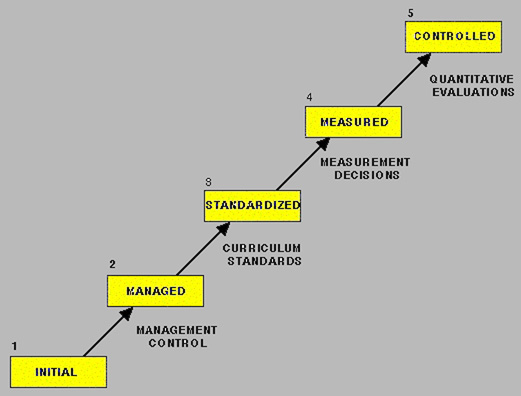|
The Curriculum Improvement Model concept was inspired by the Capability Maturity Model
(CMM) of software process improvement, developed at the Software Engineering Institute of Carnegie Mellon University, to address the continuing problems of poor software quality, missed schedules, and overrun budgets. The CMM is a five-level hierarchical scheme in which fundamental processes (such as management and standardization) are first put under control, and then the entire process is measured and improved on a continuing basis. The CMM methodology has become the most popular way for companies to address their software development techniques, and is now required by the Department of Defense for all contracts.
The Curriculum Improvement Model consists of Levels (rectangles) that describe general points of achievement in the curriculum improvement process, and Process Groups (arrows) that describe what is needed to reach the next
Level (see diagram below).

Initial Level
The Initial Level describes a curriculum development process that has few (if any) controls or standards. Techniques used by the teachers to develop curricula are not standardized or written down, and not necessarily followed by all teachers. There is no recognition of what information can be used in future curriculum developments.
Management Control Process Group
The Management Control Process Group consists of those functions needed to instill management standards on the curriculum development process. Examples of management controls are curriculum planning, expression of learning experience goals, quality assurance requirements, and the controlled installation of new curricula.
Managed Level
The Managed Level is a baseline for the successful implementation of all required management controls. At this level, teachers should be able to develop independent curricula with the knowledge that each final product will be consistent with the standards of the school, and will be installed without unnecessary stress on either the students or the program.
Curriculum Standards Process Group
The Curriculum Standards Process Group consists of those functions needed for technical standardization and for a wider view of the curriculum development process. Examples of curriculum standards are establishing a standard process (and a process improvement group) for improving curricula, developing a training program in curriculum development for new teachers, analyzing strengths and weaknesses of current curricula, beginning to collect data on the process changes, and including a peer review for all new curriculum developments. Information is also collected and evaluated for new products that may be useful in classroom instruction.
Standardized Level
The Standardized Level is a baseline for the successful implementation of all required curriculum standards. At this level, teachers should be able to develop curricula, refine applications, and make revisions based on need and modernity that are consistent with their own program and with related programs in the school. There is also the start of a continuing improvement process and closer communications among all teachers.
Measurement Decisions Process Group
The Measurement Decisions Process Group consists of deciding which additional metrics are needed for continuing improvement of the curriculum development process. Data should be collected and analyzed for each approved metric. In addition, variations in curriculum developments should be analyzed and minimized.
Measured Level
The Measured Level is a baseline for the successful implementation of all required measurement decisions. At this level, teachers should be able to begin quantitative evaluations of their curricula, and measure the effects of any changes to them. In this same way, teachers should be able to better control developments of new curricula.
Quantitative Evaluations Process Group
The Quantitative Evaluations Process Group consists of performing cross-analyses of the metrics being collected, and proposing management decisions based on them. Quantitative improvement goals for continuing curriculum improvement, such as a 5% increase in student test scores, can also be set based on the data collected.
Controlled Level
The Controlled Level is a baseline for the successful implementation of the quantitative evaluation processes. At this level, teachers should be able to justify curriculum changes both pedagogically and economically based on the data that have been collected and analyzed. The entire curriculum development process should be stable, measurable, and producing an educational experience that is continuously improving.
|
![[Advance to the EPICENTER home page]](images/backhome.gif)

We hope you found what you needed on this page. If you have
any questions or comments, please contact me.

Howard Jeffrey Bender, Ph.D.
President
The Education Process Improvement Center, Inc.
11970 Grey Squirrel Lane
Reston, Virginia 20194
hjbender@epicent.com
|



![]()